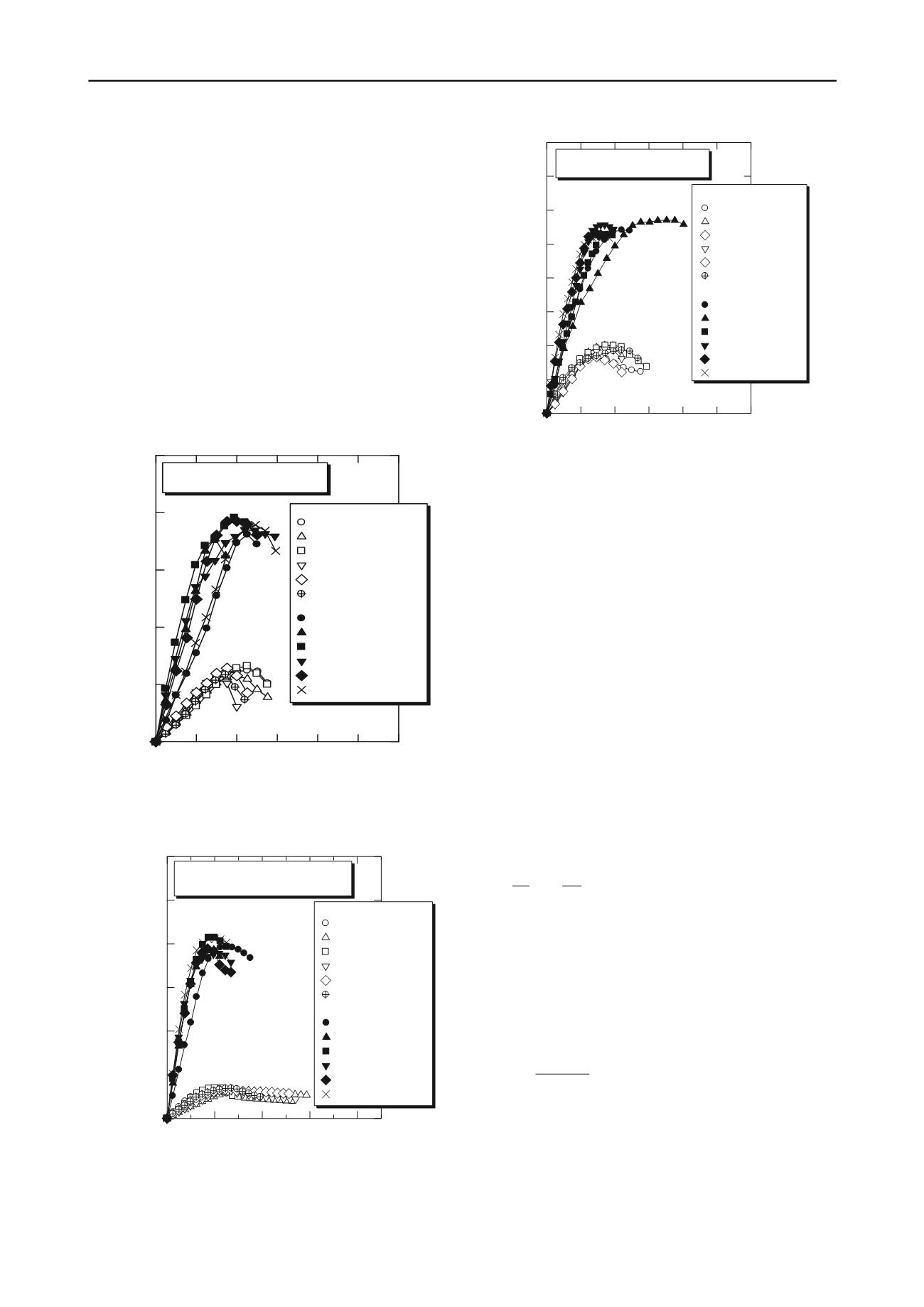
347
Technical Committee 101 - Session II /
Comité technique 101 - Session II
Proceedings of the 18
th
International Conference on Soil Mechanics and Geotechnical Engineering, Paris 2013
Figures 3 to 5 show the stress~strain relationships in
unconfined compression tests of samples with different air
contents and cement contents but with the same
V
/
C
values of
30 and 10, at 14 days of curing. Figure 3 is for the lightweight
cemented kaolin at water content of 88%. Figure 4 is for the
lightweight cemented Bangkok clay at water contents of 136%.
Figure 5 is for the lightweight cemented bentonite at water
contents of 170%. It is noted that as
V
/
C
decreases, the
cementation bond strength increases and hence strength. The
lightweight cemented samples with the same void/cement
exhibit the similar stress-strain behavior. To conclude, the
V
/
C
controls compressive strength and compression characteristic in
pre-yield state for a particular water content, while the unit
weight does not, which is different from natural clays. The
fabric (arrangement of clay particles, clusters and pore spaces)
reflected from both air foam content and water content is taken
into consideration by the void volume while the inter-particle
forces (levels of cementation bond) are governed by the input of
cement (cement volume).
0 0.5 1.0 1.5 2.0 2.5 3.0
0
200
400
600
800
1000
A
c
=0%,C =73.3 kg/m
3
A
c
=10%,C =76.39 kg/m
3
A
c
=20%,C =79.5 kg/m
3
A
c
=30%,C =82.7 kg/m
3
A
c
=40%,C =85.8 kg/m
3
A
c
=50%,C =88.96 kg/m
3
A
c
=0%,C =219.7 kg/m
3
A
c
=10%,C =229.2 kg/m
3
A
c
=20%,C =238.6 kg/m
3
A
c
=30%,C =248.0 kg/m
3
A
c
=40%,C =257.44 kg/m
3
A
c
=50%,C =266.9 kg/m
3
V/C =30
V/C =10
Lightweight cemented kaolin
w
=88%
Axial stress (kPa)
Axial strain (%)
Figure 3. Stress-strain relationship of air-cement-admixed kaolin at
w
=
88%.
0
1.0
2.0
3.0
4.0
0
500
1000
1500
2000
2500
3000
A
c
=0%,C =81.9 kg/m
3
A
c
=10%,C =84.2 kg/m
3
A
c
=20%,C =86.4 kg/m
3
A
c
=30%,C =88.7 kg/m
3
A
c
=40%,C =91.0 kg/m
3
A
c
=50%,C =93.3 kg/m
3
A
c
=0%,C =245.6 kg/m
3
A
c
=10%,C =252.4 kg/m
3
A
c
=20%,C =259.3 kg/m
3
Axial stress (kPa)
Lightweight cemented Bangkok clay
w
=136%
Axial strain (%)
A
c
=30%,C =266.1 kg/m
3
A
c
=40%,C =273.0 kg/m
3
A
c
=50%,C =279.8 kg/m
3
V/C =30
V/C =10
Figure 4. Stress-strain relationship of air-cement-admixed Bangkok clay
at
w
= 136%.
0 0.5 1.0 1.5 2.0 2.5 3.0
0
500
1000
1500
2000
2500
3000
3500
4000
A
c
=0%,C =85.1 kg/m
3
A
c
=10%,C =87.0 kg/m
3
A
c
=20%,C =89.0 kg/m
3
A
c
=30%,C =91.0 kg/m
3
A
c
=40%,C =92.9 kg/m
3
A
c
=50%,C =94.9 kg/m
3
A
c
=0%,C =255.2 kg/m
3
A
c
=10%,C =261.1 kg/m
3
A
c
=20%,C =266.9 kg/m
3
Axial stress (kPa)
Lightweight cemented bentonite
w
=170%
Axial strain (%)
A
c
=30%,C =272.8 kg/m
3
A
c
=40%,C =278.7 kg/m
3
A
c
=50%,C =284.6 kg/m
3
V/C =30
V/C =10
Figure 5. Stress-strain relationship of air-cement-admixed bentonite at
w
= 170%.
Figures 1 to 5 show the advantage of using air form to
produce the lightweight cemented clay. The strength reduction
is observed when the void increase by air form due to the
increase in contact area per cementation bond. However, the
role of air content on the strength development is less
significant than that of cement and water. This is because the
hydration is strongly depended on the water/cement ratio in the
mix. In other words, by using the air form, the unit weight is
significantly reduced with less strength reduction.
Because the
V
/
C
is the prime parameter governing the
engineering properties in elastic range (at low effective
confining stress), it is possible to develop a relationship
between strength and
V
/
C
for a particular curing time. Figure 6
shows the relationship between strength and
V
/
C
at 7 days of
curing of the lightweight cemented Bangkok clay as an example
to guarantee the applicability of the
V/C
. The unique
relationship between strength and
V/C
can be found for a given
initial water content at different cement contents and air
contents. Based on the experimental observations (5 <
V
/
C
< 40
and 7 days of curing), it is possible to advance the following
identity:
1
2
1
2
Constant
V V
C C
(1)
Once the void/cement ratio is fixed in the field, if the air
content (void volume) is changed to achieve the required unit
weight, the cement content can be estimated from Eq.(1) to
attain the same strength and compressibility characteristics. For
a mix design purpose, the relationship between strength and
V/C
at a certain water content is advanced on the basis of Abrams’
law (1918):
/
u
B
A q
V C
(2)
where
q
u
is the unconfined compressive strength,
V/C
is the
void/cement ratio, and
A
and
B
are constants. This equation
when
A
c
= 0 yields the same equation proposed by Horpibulsuk
et al. (2011a, b and 2012a). The
A
-value is dependent upon the
clay type, curing time and air content. As the water content
increases, the
A
-value decreases. The
B
-value is practically
constant and equal to 1.26 to 1.29, which is the typical values


